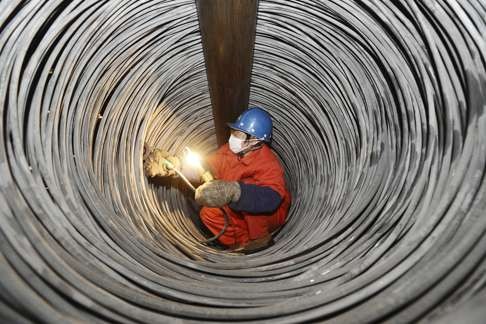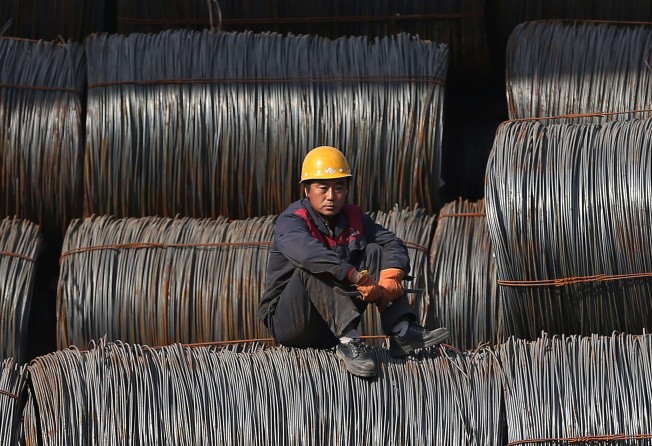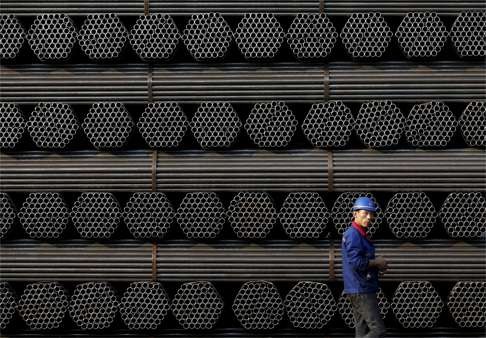
Baosteel-Wisco marriage sets stage for faster steel industry consolidation

The landmark merger of Baosteel Group and Wuhan Iron and Steel Group (Wisco) will help quicken consolidation of China’s steel sector, bringing important reforms back on track that had fallen behind expectations of senior economic planners in Beijing.
But Beijing’s efforts to combine the nation’s largest steel mills will only be effective in curbing excess capacity if low steel prices and industry barrier regulation enforcement persist, according to some analysts.
“We do not think that [such a merger] will have an immediate impact on the overall sector capacity elimination,” Fitch Ratings director of Asia Pacific corporates Laura Zhai said in a note. “Small steel mills in China do not compete with Baosteel and Wisco, which produce high-end steel products. Smaller [inefficient] mills are not likely to be eliminated without the enforcement of more stringent environmental requirements and prolonged low prices.”
Citi’s metals and mining analyst Jack Shang said in a note that although news of mergers and capacity closures would support short-term investor sentiment toward China’s steel sector, he is cautious on the outlook since the government’s concern about non-performing loans remains a stumbling block for large scale plant closures.
China’s steel industry has 1.2 billion tonnes of annual excess capacity, particularly for low-end products. Average plant utilisation fell from 89 per cent in 2006 to 67 per cent last year, according to the World Steel Association.
China’s steel demand has been on a downward trend since hitting an annual growth rate of 18 per cent in 2005. Beginning in 2014 China’s annual steel consumption contracted by a low single-digit percentage.
Exports of Chinese steel surged 20.5 per cent last year and a further 6.3 per cent in the first eight months of this year, as domestic mills looked to foreign markets to offset the shortfall in demand at home.
Amid mounting losses of China’s steel sector and pressure from other nations accusing the mainland of unfair trade practises related to “dumping” steel products at or below cost, Premier Li Keqiang in January unveiled plans to eliminate up to 150 million tonnes of inefficient capacity in five years. About 100 million tonnes of annual excess capacity have been shuttered in recent years.
However, progress has been slower than expected in the first seven months of this year, with the industry eliminating only 47 per cent of the 45 million tonne target for 2016.
The capacity reduction is part of President Xi Jinping’s so-called supply-side reform and state owned enterprises (SOEs) reform, aimed at instilling market discipline to their management so that they can withstand slower annual economic growth.
The Chinese steel industry has also fallen well behind Beijing’s 2011 goal to have the top 10 steel mills amass a 60 per cent share of the nation’s steel market by 2015. Instead, China’s steel-making sector has become more fragmented as new plants have come online, many planned and funded by private groups when steel prices were souring.

The so-called industry concentration ratio among the top 10 players stood at 34 per cent last year, down from 51 per cent in 2011, according to a Citi research.
At the time it was thought that higher concentration would bolster the industry’s bargaining power in iron ore procurement, which is dominated by a few Australian and Brazilian firms.
Beijing has not given up on the 60 per cent concentration target. The Ministry of Industry and Information Technology last year reiterated its commitment to the target but revised the date for compliance to 2025.
Li Hongmei, senior editor for metals and steel at information provider S&P Global Platts, believes the new target is reachable, adding that the merger of Baosteel and Wisco is estimated by industry to lift the concentration ratio to 36 per cent.
Li said while it was difficult to reach consensus on industry consolidation during the commodity boom, a new atmosphere of pragmatism has taken hold.
“Now the industry environment has deteriorated to such a degree that some mills are warming to the idea of either selling out or shutting shop,” she said.
Mergers and acquisitions have been taking place despite official data pointing to rising industry fragmentation.
According to industry web-site custeel.com, some 75 mergers were announced in China’s steel industry in the past two decades.
But these were mostly the absorption of smaller players by large players, in addition to mergers among mid-size or small-size mills.
SWS Research analyst Meng Yeyong believes the merger of Baosteel and Wisco signals a change in Beijing’s approach toward the steel industry’s consolidation, and could herald other mergers among industry leaders, as the latter will be under pressure to enhance their competitiveness.
Candidates include Hebei province-based Hesteel Group, which will be usurped as the nation’s top steel firm by China Baowu Iron and Steel Group upon Baosteel and Wisco’s merger. Other candidates include eastern China’s Shagang Group, northeast China’s Anshan Iron and Steel Group, Shougang Group, Shandong Iron and Steel Group and Maanshan Iron and Steel Group.
“By merging some of the industry’s strongest players whose production footprint are geographically complementary, competitiveness of the leading producers will be augmented,” Meng said in a report.
“This will compress small and medium-sized players’ room of survival so that the elimination of inefficient capacity can be sped up and the economies of scale effect can be realised quicker.”
Meng noted the result from the previous two decades of mergers between large and smaller players has proved disappointing.
“The hope was that the big mills would use their advanced production and management know-how to help lift the profitability of smaller, less efficient ones ... but it turns out they only delayed the inevitable capacity elimination,” he said.
Both Baosteel and Wisco have absorbed smaller players in the past decade. Baosteel acquired Bayi Iron and Steel in the remote northwestern Xinjiang Uygur autonomous region and Shaoguan Iron and Steel in Guangdong province.
Bayi and Shaoguan made a combined net loss of 1.46 billion yuan for the first half, compared to Baosteel’s Shanghai-based listed flagship Baoshan Iron and Steel’s profit of 5.14 billion yuan, according to Baosteel’s corporate bond investors circular.
Li said Xinjiang’s less developed economy would make it tough for Bayi to find consolidation partners, even though the local market has good growth potential in the long term.
All three of Wisco’s main steel producing units recorded losses last year, leading to a combined net loss of 12.2 billion yuan. But for the first half of this year Wuhan Iron and Steel (Wugang) had a profit of 3.47 billion yuan, compared to a profit of 79 million yuan of listed Liuzhou. Interim results of unlisted Kunming were not available.
However, unlike the failed merger in 2005 between Anshan Iron and Steel Group and Benxi Iron and Steel Group, which formed a merged entity by name but failed to agree on terms, Baosteel and Wisco announced the merger of their respective listed flagships the day Beijing approved their marriage.
Each Wugang share is exchangeable into 0.56 Baoshan share.
When and how the two parent groups’ other loss-making or less profitable units will be integrated remains unknown.
Baoshan said in a shareholders’ circular issued on October 1, it will seek to “fully integrate” its operation with that of Wugang, in terms of strategy, research and development, procurement, production, sales and management, and “maximise” the benefits from larger operating scale.
It will “highly coordinate” production activities at the merged entities’ manufacturing bases, concentrate procurement, and consolidate distribution and logistics centres.
Baoshan also said it will upgrade or dispose of inefficient assets, and strengthen control on operational, management and finance costs.
But it did not give any cost savings estimates and warned investors that “it will take a relatively long process” to integrate the two companies’ operations due to “difficulties in consolidating their procurement, production, sales and human resources within a short period of time”.
The circular also did not mention whether the merger would result in anticompetitive concerns, given the merged entity would create a giant with over 70 per cent of China’s electrical steel market.
However, it warned investors of the risk that their holding in Baoshan could be diluted. The dilution would amount to 29 per cent had the deal been completed on June 30, the circular said.
The circular also noted the shares swap ratio values Baoshan at only 0.66 times its book value at the end of June, much lower than 0.96 times book value at which Wugang is valued, and also less than the average 0.88 times of five peers.
On an enterprise value-to-enterprise value multiple basis, Baoshan was valued at 6.94 times, lower than 9 times for Wugang and the average of 9.9 times.
“Although the merger’s valuation of Baoshan both on the price-to-book value basis and EV/Ebitda basis was substantially lower than that of merger target Wugang and some industry peers, one should not conclude that it was necessarily unfavourable to Baoshan’s shareholders,” said DBS Vickers analyst Addison Dai. “One also needs to take into account the historical valuation for the two listed units.”
The historical five-year average price-to-book ratio of Baosteel is 0.7 and that of Wugang is 1.1, she noted.
Hesteel, the listed flagship of the industry’s No 1 player Hegang, was valued at 0.66 times its book value at the end of June. Angang Steel, the listed unit of the fourth largest player, fetched 0.63 times book value.
“The valuation gap reflects investors’ appetite as larger capitalisation stocks in the Shanghai stock market...tend to trade at a discount to mid and small-size firms in the same industry,” she said.